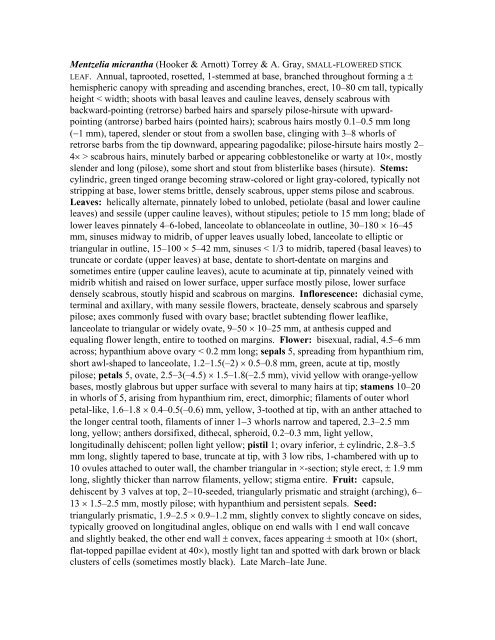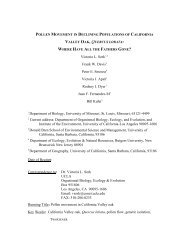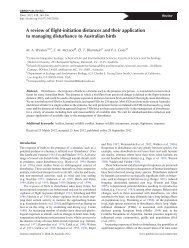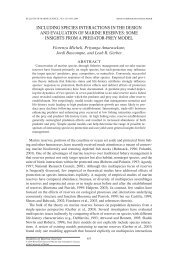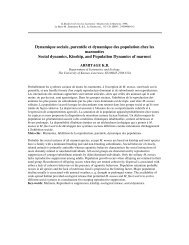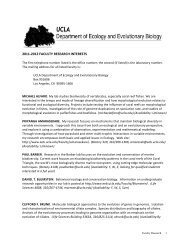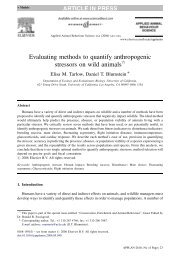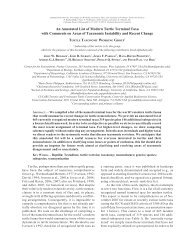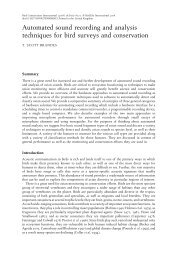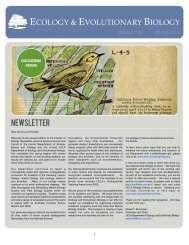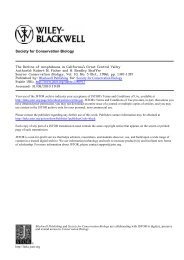Mentzelia micrantha (Hooker & Arnott) Torrey & A. Gray, SMALL ...
Mentzelia micrantha (Hooker & Arnott) Torrey & A. Gray, SMALL ...
Mentzelia micrantha (Hooker & Arnott) Torrey & A. Gray, SMALL ...
Create successful ePaper yourself
Turn your PDF publications into a flip-book with our unique Google optimized e-Paper software.
<strong>Mentzelia</strong> <strong>micrantha</strong> (<strong>Hooker</strong> & <strong>Arnott</strong>) <strong>Torrey</strong> & A. <strong>Gray</strong>, <strong>SMALL</strong>-FLOWERED STICK<br />
LEAF. Annual, taprooted, rosetted, 1-stemmed at base, branched throughout forming a ±<br />
hemispheric canopy with spreading and ascending branches, erect, 10–80 cm tall, typically<br />
height < width; shoots with basal leaves and cauline leaves, densely scabrous with<br />
backward-pointing (retrorse) barbed hairs and sparsely pilose-hirsute with upwardpointing<br />
(antrorse) barbed hairs (pointed hairs); scabrous hairs mostly 0.1–0.5 mm long<br />
(−1 mm), tapered, slender or stout from a swollen base, clinging with 3–8 whorls of<br />
retrorse barbs from the tip downward, appearing pagodalike; pilose-hirsute hairs mostly 2–<br />
4× > scabrous hairs, minutely barbed or appearing cobblestonelike or warty at 10×, mostly<br />
slender and long (pilose), some short and stout from blisterlike bases (hirsute). Stems:<br />
cylindric, green tinged orange becoming straw-colored or light gray-colored, typically not<br />
stripping at base, lower stems brittle, densely scabrous, upper stems pilose and scabrous.<br />
Leaves: helically alternate, pinnately lobed to unlobed, petiolate (basal and lower cauline<br />
leaves) and sessile (upper cauline leaves), without stipules; petiole to 15 mm long; blade of<br />
lower leaves pinnately 4–6-lobed, lanceolate to oblanceolate in outline, 30–180 × 16–45<br />
mm, sinuses midway to midrib, of upper leaves usually lobed, lanceolate to elliptic or<br />
triangular in outline, 15–100 × 5–42 mm, sinuses < 1/3 to midrib, tapered (basal leaves) to<br />
truncate or cordate (upper leaves) at base, dentate to short-dentate on margins and<br />
sometimes entire (upper cauline leaves), acute to acuminate at tip, pinnately veined with<br />
midrib whitish and raised on lower surface, upper surface mostly pilose, lower surface<br />
densely scabrous, stoutly hispid and scabrous on margins. Inflorescence: dichasial cyme,<br />
terminal and axillary, with many sessile flowers, bracteate, densely scabrous and sparsely<br />
pilose; axes commonly fused with ovary base; bractlet subtending flower leaflike,<br />
lanceolate to triangular or widely ovate, 9–50 × 10–25 mm, at anthesis cupped and<br />
equaling flower length, entire to toothed on margins. Flower: bisexual, radial, 4.5–6 mm<br />
across; hypanthium above ovary < 0.2 mm long; sepals 5, spreading from hypanthium rim,<br />
short awl-shaped to lanceolate, 1.2–1.5(–2) × 0.5–0.8 mm, green, acute at tip, mostly<br />
pilose; petals 5, ovate, 2.5–3(–4.5) × 1.5–1.8(–2.5 mm), vivid yellow with orange-yellow<br />
bases, mostly glabrous but upper surface with several to many hairs at tip; stamens 10–20<br />
in whorls of 5, arising from hypanthium rim, erect, dimorphic; filaments of outer whorl<br />
petal-like, 1.6–1.8 × 0.4–0.5(–0.6) mm, yellow, 3-toothed at tip, with an anther attached to<br />
the longer central tooth, filaments of inner 1−3 whorls narrow and tapered, 2.3–2.5 mm<br />
long, yellow; anthers dorsifixed, dithecal, spheroid, 0.2–0.3 mm, light yellow,<br />
longitudinally dehiscent; pollen light yellow; pistil 1; ovary inferior, ± cylindric, 2.8–3.5<br />
mm long, slightly tapered to base, truncate at tip, with 3 low ribs, 1-chambered with up to<br />
10 ovules attached to outer wall, the chamber triangular in ×-section; style erect, ± 1.9 mm<br />
long, slightly thicker than narrow filaments, yellow; stigma entire. Fruit: capsule,<br />
dehiscent by 3 valves at top, 2−10-seeded, triangularly prismatic and straight (arching), 6–<br />
13 × 1.5–2.5 mm, mostly pilose; with hypanthium and persistent sepals. Seed:<br />
triangularly prismatic, 1.9–2.5 × 0.9–1.2 mm, slightly convex to slightly concave on sides,<br />
typically grooved on longitudinal angles, oblique on end walls with 1 end wall concave<br />
and slightly beaked, the other end wall ± convex, faces appearing ± smooth at 10× (short,<br />
flat-topped papillae evident at 40×), mostly light tan and spotted with dark brown or black<br />
clusters of cells (sometimes mostly black). Late March–late June.
Native. Annual occasionally found in openings or on burns of chaparral throughout the<br />
range. <strong>Mentzelia</strong> <strong>micrantha</strong> has distinctive foliage that clings tenaciously to clothes (=<br />
poor man’s patches) because the leaves and bracts are covered with barbed hairs that catch<br />
fabric like grappling hooks. Its stems age with a smooth, straw-colored surface. This<br />
species has a flower with an inferior ovary and 5 vivid yellow petals, and the filaments of<br />
the outer stamens are petal-like.<br />
B. A. Prigge & A. C. Gibson


